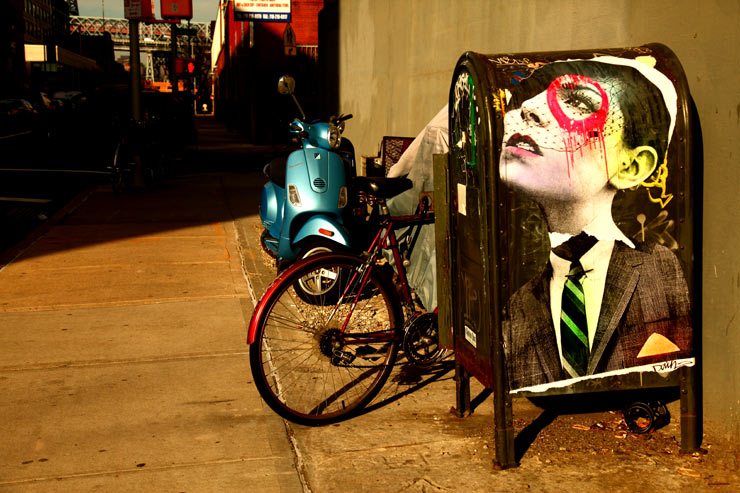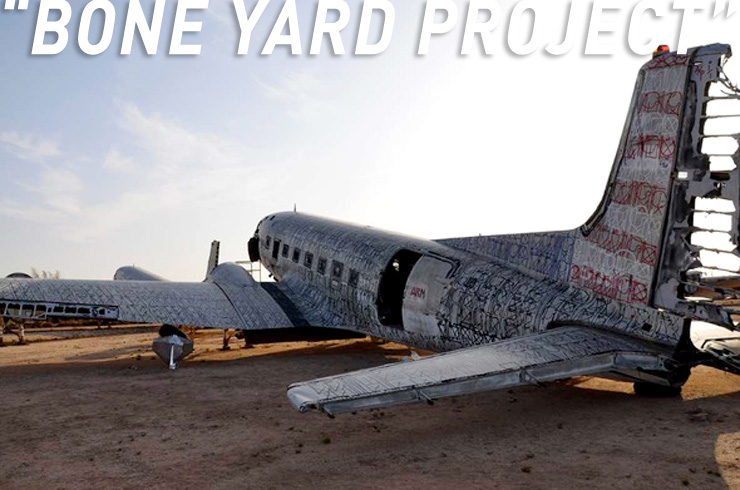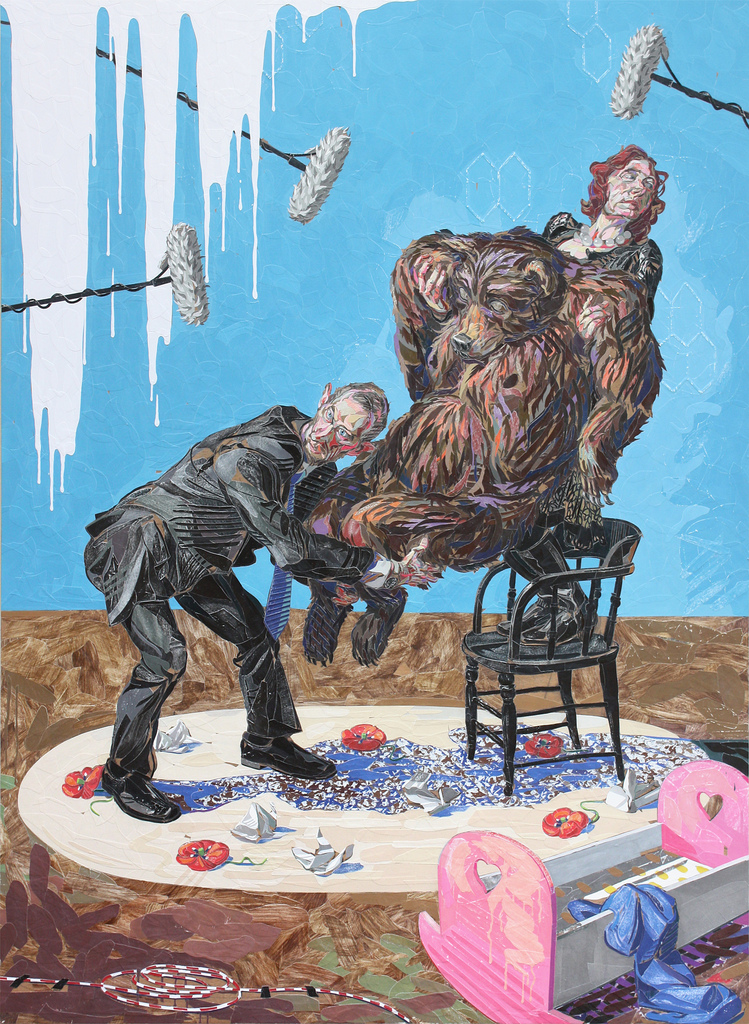|
|
Today on Fun Friday:
1.”Making Faces” at Opera Gallery (Soho, NY)
2. “Nostalgia” at Rook & Raven (London)
3. “Bone Yard Project” at Pima Air & Space Museum (Tucson, AZ)
4. Phlegm at Nuart (VIDEO)
5. Official Trailer for “Getting Up” (VIDEO)
6. The Big Egg Hunt: Baku Magazine x Secret Wars (VIDEO)
An unusual collection of portraiture is on display starting today in Soho that knocks your head for a spin because of it’s loose theme that can stretch to embrace a century or two, a few continents, and about 30 schools of art.
Favorite pairing from last nights opening: Picasso next to Judith Supine. If he only knew.
“Making Faces” throws a cocktail party for old masters along with contemporary fine and Street Artists, including Judith Supine, Bast, Paul Insect, Rostaar, B., Zhang Xiaogang, Ron English and Kid Zoom sharing wall space with Chagall, Matisse, Miro and Basquiat among others.
For further information regarding this show click here
At the Rook & Raven Gallery in London the group show “Nostalgia” opens todaywith new works by Various & Gould, Dain, David Shillinglaw and Stinkfish, among others.
Various & Gould in Brooklyn, NY (photo © Jaime Rojo)

Here is a video of David Shillinglaw, who prepared his piece for the “Nostalgia” show over the course of a week:
Another mind-blowing project – curated by Medvin Sobio and Carlo McCormick and conceived by Eric Firestone – opens tomorrow in Tucson, where there is a lot of space. Carcasses of planes lovingly wrecked by artists you love; The Pima Air & Space Museum in Tucson, Arizona announces the opening of “Round Trip: Art From The Bone Yard Project” this Saturday January 28. 
More than 30 artists have participated in Round Trip including DC Super 3 planes painted by graffiti artists How & Nosm, Nunca, and Retna, and a C97 cockpit by Saner, and C45 planes by Faile and Andrew Schoultz.
For further information regarding this show click here
The Bone Yard Project 2012 by Viejas del Mercado (Medvin Sobio & 塚本清市) Featuring Retna, Nunca, Saner and How & Nosm.
At the Urban Folk Art Gallery in Brooklyn founder Adam Suerte has curated a show that includes ten years of work from his personal collection. Click here for more information.
“After being diagnosed with ALS and rendered almost completely paralyzed, legendary L.A. graffiti artist Tony “Tempt” Quan gets his voice back through technology that reads the movement of his eyes and enables him to create art and write once again.”
Marcelina and Mr. Hicks paint their big egg.
Art From The Bone Yard Project

The Pima Air & Space Museum is pleased to announce the opening of Round Trip: Art From The Bone Yard Project on January 28 in Tucson. Conceived in Spring 2010 by Eric Firestone, and organized with curators Medvin Sobio & Carlo McCormick, The Bone Yard Project resurrects disused airplanes from America‟s military history through the creative intervention of contemporary artists, taking entire airplanes and their elements out of aeronautic resting spots in the desert, known as “bone yards,” and putting them into the hands of artists. Re-imagined by Brazilian graffiti artist Nunca, an abandoned DC3 comes to life with a striking picture of an eagle leading men through the skies, and the idealized dreams of flight are able to soar once again in our collective imagination. With a nod to the airplane graffiti and „nose art‟ that became popular during WWII, the project offers a vision of the wonder by which humanity takes to the air through some of the most prominent and acclaimed artists working today.
Round Trip: Selections from The Bone Yard Project, will include selections from the previous exhibition along with more than a dozen cones interpreted by artists new to this project. It will feature five monumental works created on military planes by a dynamic selection of popular graffiti and street artists from around the world. The curatorial team includes Medvin Sobio, an independent curator and consultant, and Lesley Oliver of the Scottsdale Museum of Contemporary Art, a longstanding figure on the Arizona art scene.
More than 30 artists have participated in Round Trip including DC Super 3 planes painted by graffiti artists How & Nosm, Nunca, and Retna, and a C97 cockpit by Saner, and C45 planes by Faile and Andrew Schoultz. Additionally, Nose Job artists Aiko, Peter Dayton, Shepard Fairey, Futura, How and Nosm, Mare, Tara McPherson, Richard Prince, Lee Quinones, Saner, Kenny Scharf, and JJ Veronis will be on display, along with new nose cones by artists Colin Chillag, Crash, Daze, Daniel Marin Diaz, Tristan Eaton, Jameson Ellis, Ron English, Faile, Eric Foss, Mark Kostabi, Lisa Lebofsky, El Mac, Alex Markwith, Walter Robinson, Hector Ruiz, Randy Slack, Ryan Wallace, and Eric White, among others.
The Pima Air & Space Museum is the largest non-government funded aviation museum in the United States, and one of the largest in the world. It maintains a collection of more than 300 aircraft and spacecraft from around the globe and more than 125,000 artifacts. The museum is located at 6000 E. Valencia Rd. , Tucson, and is open 9:00 AM – 5:00 PM daily. Round Trip is open to the public from January 28 through the end of May 2012. Further details may be found at www.pimaair.org.
The following essay by Steven P. Harrington and Jaime Rojo, co-founders of Brooklyn Street Art, appears in the book “Eloquent Vandals The History of Nuart”, edited by Martyn Reed, Marte Jølbo, and Victoria Bugge Øye and published in 2011 by Kontur Publishing. More information appears after the essay.
The Internet and the increasing mobility of digital media are playing an integral role in the evolution of Street Art, a revolution in communication effectively transforming it into the first global people’s art movement.
While that may seem hyperbolic, just witness the millions of images of Street Art uploaded on photo sharing sites, the time lapse videos and full length films online, the hundreds of blogs, websites, discussion forums, chatrooms, Facebook pages, Twitter addresses, and phone and tablet apps dedicated entirely or partially to Street Art and graffiti and the multifaceted culture that grows around it. Thousands of people daily are populating the databases, compiling a mountainous archive of something once quaintly referred to as an ephemeral art. This said, the transformative story is that the images are now freed from their sources to float in the ether for anyone with a digital device to access. Within the space of a decade, art that once lived and died on a wall with a local population is now shared via digital capture and upload, gaining access to a worldwide audience. Immediately.
The multi-authored amorphous swirling whirlwind of street art, graffiti, public art, and urban art is simply too vast for any person to get their arms around or explain – yet our digital media tribes are enabling us to collect it, share it, and study it in larger numbers than ever imaginable. As artists and professionals for 25 years in New York, a city with a legacy of graffiti all its own, we have been extremely lucky to witness the blossoming of the current Street Art movement; to document it, analyze it, discuss it, and share it by real world means and virtual means with thousands of others. With the dual forces of high rents and corporate gentrification pounding the final nails into the coffin of the established creative neighborhoods in Manhattan, gritty bubbling new and youthful artist neighborhoods of Brooklyn became de facto showcases for the Street Art scene at the turn of the century, and we were shooting images and tracking its evolution from the beginning.
In concert with the Internet, all manner of art that occurs in the streets is being captured and shared, discussed, critiqued, celebrated or dismissed by people of searing intellect and those who cannot locate their own country with their finger if you spin a globe in front of them. As text has been loosed from print in this post Gutenberg Parenthesis world of Sauerberg, so too our local Street Art is freed from its wall. Going from “All City” to “All Timezones” has radically transformed how Street Artists perceive their work and their audience, with the concept of “place” profoundly altered.
Nuart became a focal point for many in the Street Art world in the early 2000s because of its highly curated nature and its expansive brand of personal interaction with public space. A hybrid of high-minded civic involvement and an art form with roots solidly in anti-authoritarianism, Nuart has presented a rolling roster of Internet stars and miscreants of the Street Art scene. It’s a highly unusual mix: quality experimental elements birthed by the interconnectedness of the virtual world, soon imitated by other entrepreneurial Street Art enthusiasts. With the help of the Internet this Norwegian port town of Stavanger is an international player in the Street Art scene, a by-invitation celebration capable of drawing a wide range of serious talent to create epic pieces in singular locations. When the images and videos of installations at Nuart are relayed through the forums and chatrooms and blogs and Flickr pages around the world, other cities begin rethinking public space and examining with a new interest the players in their own Street Art scene.
A large part of our understanding of art and its expression for generations has come from textbooks, lorded over by scholars and experts who were trained by others using similar texts passing along received knowledge and prejudices. For those rebels of the graffiti and Street Art movement who have never given much credence to formal education, the unbound and chaotic nature of digital communications actually feels more organic and trustworthy. In large part, with the exception of the formalism of the logical structure comprising the undergirding of the Internet, its explosive growth has been more intuitive and behavioral than left-brained or hierarchical. The beauty of a new Street Art piece on a nearby wall is electrifying to share with the digital tribe, and in so doing, it legitimizes ones status among peers and the work of the artist as well. With the innate desire to learn being regularly quenched by members of this tribe, collective intelligence is rising more quickly than any organized curricula could ever aspire.
Graffiti and Street Artists have always benefitted from documentation of photographers like John Naar, Keith Baugh, Martha Cooper, Henry Chalfant, and James Prigoff, who are largely responsible for the capture and preservation of the historical knowledge we now have of graffiti in New York City during the 1970s and 1980s. Without the benefit of instant communication of these images, copies of Cooper and Chalfant’s book Subway Art and Charlie Ahearn’s movie Wild Style relied upon actual physical distribution channels and commerce to travel around the world and inspire young artists. “Viral” was a word associated with antibiotics.
As film turned to digital at the turn of the century and cameras and personal computers became far more affordable, the convergence of technology gave professional and amateur photographers the incentive to roam the streets hunting for street art and the ability to have the instant gratification of seeing their photos online. As in the early days of graffiti, Street Artists of the 2000s didn’t shy away from the attention photographers were giving to their work and a new symbiotic relationship between the street artists and web savvy photographers was born where certain artists would place their work where it was likely to be seen and photographed, and hopefully distributed online. Like the days of Cooper et al., digital photographers assisted many of the current stars of Street Art to gain exposure to an appreciative fan base and to increase their popularity during the decade.
With the introduction of the online image-sharing platform called Flickr in 2004, the already rapid spread of Street Art photography completely ballooned as fans from every city and town and hamlet began uploading their Street Art images to one location where everyone could coalesce around their common interest. With a database structure and system for tagging, images could be categorized, sorted and most importantly, searched. No longer reliant on the approval of gatekeepers or site curators, Street Artists gained autonomy and audience largely on their own terms and with the help of photographers who scoured the streets to capture their work. Of the current 6 billion or so images uploaded to the site since then, millions are of street art – a de facto common repository and shared research archive for artists, professionals, curators, collectors, and casual fans.
A new central nervous system in formation, Flickr and other lesser-known sharing platforms had a profound causational relationship to the dissemination of Street Art culture to a worldwide audience. You knew Melbourne and Bristol and São Paulo and New York had a Street Art scene, but Sacramento? Shanghai? Stavanger? In addition to images and videos, the platform provided common space for exchange of opinion, ideas, and news, fostering online and offline relationships and enabling Street Artists and photographers to pursue their work as a possible career route.
Photo sharing sites of course are not the only means for the worldwide distribution and formation of a common understanding of Street Art culture. Today’s digital biosphere includes primary content sites and blogs, aggregators (or self-described “curators”), peer-to-peer forums, Social Media, and mobile apps as part of the overall knowledge base, forming an increasingly common understanding about Street Art, it’s origins and it’s evolving expression in the public sphere. No one can doubt that this familiarity has only aided its popularity.
In one significant role-reversal, the online experience of Street Art has also altered the behaviors on the streets and once sacrosanct “rules” of the street have been turned on their head. Although it was once verboten to reveal a street location for fear of reprisal, now both street artists and fans geotag their images so they can be found on a map with any GPS enabled device. As mobile device use eclipses Internet use in the next couple of years and hardware and software becomes more flexible, sophisticated, affordable, and available, there is no doubt that more apps and platforms using mapping and GPS are likely to thrive. Whether through image sharing platforms or mobile apps, these systems of tagging are providing exact information for self-guided tours by fans and tour groups, peers, enemies, and of course, law enforcement.
Excerpts from additional subtopics of this essay:
“The growth of connectivity is producing a foundational change to the world of the Street Artist and his or her relation to society as a hidden and/or marginalized figure. Increasingly it appears that it is impossible to be socially isolated when you are so busy relating, even if anonymously. Unwittingly, the stereotypical vision of the outsider is melting as one is pulled into a collective environment where peers regulate and monitor the actions of one another and settle disputes or give encouragement and opportunities. The new digital world, once thought to be impersonal, is increasingly fluid, intuitive, and connected; enabling a near eradication of feelings of estrangement, ostracization, marginalization, and isolation for many people, Street Artists included.”
“Arguably the act of spraying a tag or signing your name to your art can be called advertising or at the very least, branding; A Street Art purist who rejects any ideas of the advertising taint may instead put their work on the bottom side of a railroad tie, but we haven’t heard of it. Everyone understands that the primary motivation is to have one’s work seen, and thanks to the Internet and digital media, an ever-growing sophistication in self marketing is on display from Street Artists who are adept at making art, and even those who are not.”
“A certain homogenization of recurring styles, techniques, and themes due to mass disbursement also has begun, creating certain elements of an international style with clearly traced antecedents. A common language, vocabulary, and terminology that began with print media and graffiti continues to grow and refine itself. An international galaxy of galleries and festivals, and increasingly, museums, expands and contracts with lists of overlapping names traveling from continent to continent in search of walls. Listed after the artist’s name in parenthesis is the abbreviation of their country but in practice the Internet has quickly enabled them to become virtually stateless. Thanks to instant availability, a 14 year old in a sleepy small town is schooling himself with YouTube right now and with luck and skill will inherit that state as well.”
~ Steven P. Harrington and Jaime Rojo, co-founders of Brooklyn Street Art
Read the full essay in:
ELOQUENT VANDALS “THE HISTORY OF NUART”
Available Internationally on Amazon
Buy Now, Norwegian : Platekompaniet
Editors: Martyn Reed, Marte Jølbo, Victoria Bugge Øye,
Features: 304 Pages, full colour, hardcover
Format: 21 x 26cm
Language: English & Norwegian
Publisher : Kontur Publishing
Eloquent Vandals is the definitive book on one of the worlds leading street art festivals featuring exclusive essays from some of scene’s biggest names. Over 300 pages of exclusive images including works by Swoon, Brad Downey, David Choe, Vhils, Blu, Ericailcane, Logan Hicks, Dface, Nick Walker, Judith Supine, Graffiti Research Lab, Blek Le Rat and many more…
Eloquent Vandals tells the story of how Stavanger, a small city on the West Coast of Norway gained a global reputation for Street Art. For the past six years, the annual Nuart Festival has invited an international team of Street Artists to use the city as their canvas. From tiny stencils and stickers to building sized murals, from illicit wheat-paste posters on the outskirts of the city to “Landmark“ pieces downtown, found everywhere from run down dwellings and train sidings to the city’s leading galleries and fine art institutions, Eloquent Vandals documents the development of not only Nuart, but also one of the most exciting art movements of our times.
“The Internet and the increasing mobility of digital media are playing an integral role in the evolution of Street Art, a revolution in communication effectively transforming it into the first global people’s art movement.
While that may seem hyperbolic, just witness the millions of images of Street Art uploaded on photo sharing sites, the time lapse videos and full length films online, the hundreds of blogs, websites, discussion forums, chatrooms, Facebook pages, Twitter addresses, and phone and tablet apps dedicated entirely or partially to Street Art and graffiti, and the multifaceted culture that grows around it. Thousands of people daily are populating the databases, compiling a mountainous archive of something once quaintly referred to as an ephemeral art. This said, the transformative story is that the images are now freed from their sources to float in the ether for anyone with a digital device to access. Within the space of a decade, art that once lived and died on a wall with a local population is now shared via digital capture and upload, gaining access to a worldwide audience. Immediately.” – Steven P. Harrington and Jaime Rojo, Eloquent Vandals : A History of Nuart Norway
One of the three books BSA was published in during 2011, Eloquent Vandals tells the story of a Norwegian waterfront town that became a focal point for the emergence of Street Art during the first decade of the century. Edited by Marte Jølbo, Victoria Bugge Øye, and the Nuart festival founder Martyn Reed, the book explains how badass Street Artists and vandals can coalesce for a few weeks to make great walls come alive and educate through forums, roundtables, and lectures. Nuart and its accidental oracle, Mr. Reed, give us a smart and shining story of how to brilliantly engage public space with the very same artists who usually get blamed for defiling it.
Over the last few years this port called Stavanger became a high profile portal for thrilling work by many globally known Street Art explorers every September and thanks to the easy reach of digital communications, people in cities across the globe experienced it. That was the very aspect that drew us into the project; the fact that Street Art has become so global so rapidly thanks to the engagement of everyday people via digital technology. In our chapter “Freed from the Wall, Street Art Travels the World”, we deconstruct the various pathways and digital social tribes that enable an elevated consciousness about this global peoples art movement.
“A large part of our understanding of art and its expression for generations has come from textbooks, lorded over by scholars and experts who were trained by others using similar texts passing along received knowledge and prejudices. For those rebels of the graffiti and Street Art movement who have never given much credence to formal education, the unbound and chaotic nature of digital communications actually feels more organic and trustworthy.”
To be invited to participate in this book along with experts whom we admire greatly, most notably culture critic Carlo McCormick and author and lecturer Tristan Manco, is a great honor. To give background and context for a festival that includes some of the heavy talents in Street Art including Vhils, Blu, Skewville, Logan Hicks, Graffiti Research Lab, Blek Le Rat, Chris Stain, Ericailcane, Swoon, Judith Supine, Nick Walker, Dot Masters, ROA, M-City, Evol, Dan Witz and many more, it was a rare honor indeed.
Miami is in full effect! Murals and cans and scissor lifts and beers and cameras are all going at once! Street Art has never been so well represented in Miami’s Art Basel as it is this weekend – in fact it is impossible to follow it all unless you are an octopus.
And opportunities are seized, while others are missed, and some are trampled underneath. Carlo McCormick writes in Paper Mag a pleasantly prickly on-point overview of the current events with an eye toward some of the sliminess. McCormick should know about the polluting and homogenizing effect of commerce and hype on a scene born in the street, having witnessed and documented first-hand the explosion of graffiti in the NY Downtown scene during the 1980s as well as the market implosion that hurt so many artists in it’s wake. Perhaps that’s why his piece ends with the populist summation,
“It’s all good whatever side of the town you want to walk on, but to our view the art that is taking place with the 99% in mind rather than in whorish acquiescence to the 1% is infinitely more lively, vital and relevant. It may not be making much money (unlike many here we’re too polite to ask about sales), but believe it or not, that’s not the point of art. “
Read the full piece by Mr. McCormick at Paper by clicking here:
Meanwhile, the giant magnet Miami has attracted artists and their dreams and stories to paint walls today. New York photographer Mike Pearce shows BSA readers some murals in progress.
See our interview : Augustine Kofie in Studio
<<>><><><>>><>>>><<>BSA>><><>>><><>BSA
See more photos by Mike Pearce on his Flickr page here.
INVITATION
ELOQUENT VANDALS – A HISTORY OF NUART NORWAY
————————————————————————————————————————–
GUEST DJ’S, GIVE-AWAYS, OPEN BAR
ELOQUENT VANDALS WILL BE AVAILABLE FOR PURCHASE ON THE NIGHT
DB Burkeman, Monica LoCascio,
Anonymous Gallery & Rizzoli
invite you to a reception celebrating the release of the book
STICKERS: From Punk Rock to Contemporary Art
The authors and several featured artists will be in attendance.
Books will be available for purchase and signing
with DJ Jasmine Solano, DJ Mondee,
DJ Teddy King, DJ DB (Old Skool Set), Ron Morelli (L.I.E.S.),
Marcos Cabral (Runaway & On the Prowl),
& DJ Brennan Green (China Town)
Hosted by Boundless NY
Thursday, Oct. 7, 9pm
Perry Rubenstein Gallery

Brian Douglas "Bears" Photo Courtesy of the Artist